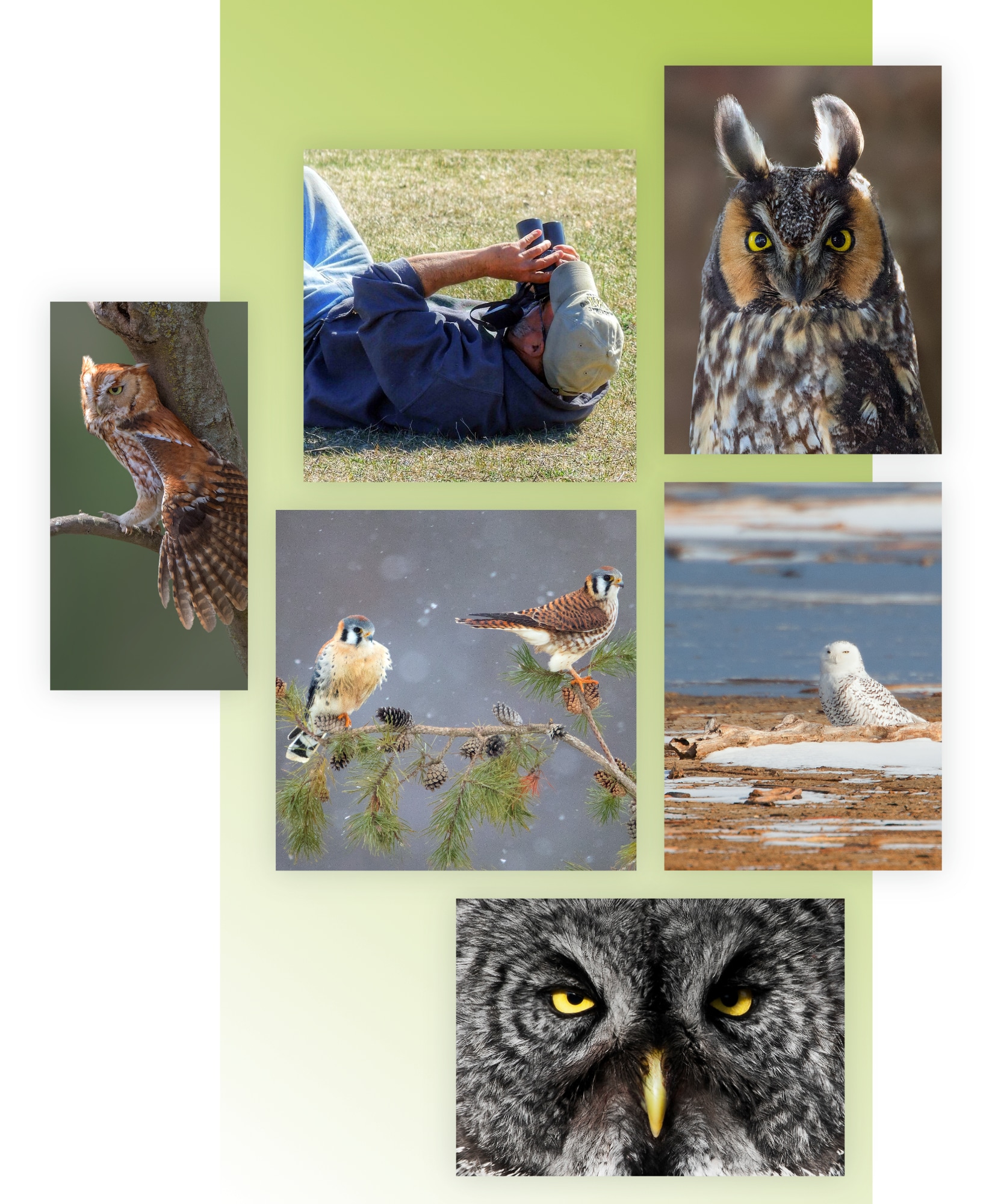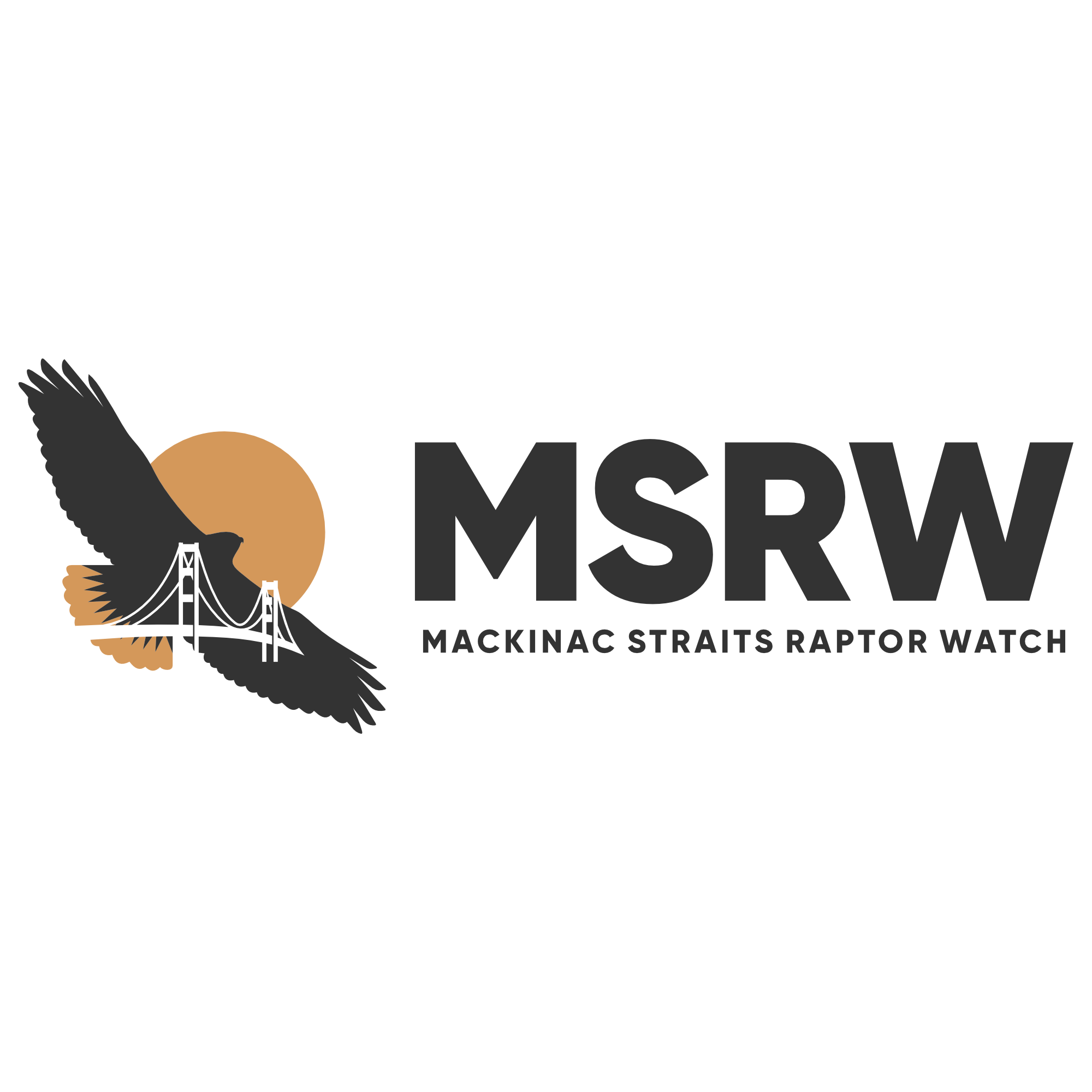Why we are here
Mackinac Straits Raptor Watch
The Straits of Mackinac in Michigan forms a unique convergence of land and water. The tapering shape of the lower peninsula concentrates migrating birds at its northern tip in the spring as they await appropriate conditions to cross the Straits. To a lesser extent, Lakes Michigan and Huron tend to funnel migrants to fly south over the Straits in the fall. Hawks and owls are of particular concern to conservationists because of their position at the top of the food web.
Raptor numbers and migration timing provide valuable insights into ecosystem conditions. The geography of the Straits makes it one of the best places in the country for studying raptors in both the spring and fall migration seasons. Because of this national significance and the region’s popularity with tourists, it is an ideal place to inspire and inform people about raptors, and about the ecological significance of the Straits of Mackinac.


History
Hawk migration over the Straits of Mackinac has been known to locals for generations. Multiple sources cite the observation of large numbers of raptors migrating in the spring, concentrated at the Straits of Mackinac. One of these sources dates back to the 1920s!
During the 1980s, MSRW co-founder Ed Pike observed large numbers of raptors moving across the Straits of Mackinac, and set up an initial hawk watch site at Darrow’s gravel pit in Mackinaw City.
In the 1980s and 1990s, Mackinac City hardware store owner Stanley McRae publicized the hawk migration here and encouraged people to experience it, as a way to increase community spirit. McRae’s charisma and enthusiasm helped build his Hawk Festival into a popular Spring event.
In 2004, Ed Pike obtained a grant of about $15,000 from the Michigan Department of Natural Resources to enable three people to officially count migrating raptors using methods established by the Hawk Migration Association of North America (HMANA)*, and to conduct owl surveys during spring and fall migration. Ed developed a site-specific hawk count protocol to enable valid year-to-year comparisons of raptor counts. That year, the paid counters worked over 46 days and tallied 13,279 raptors of 15 species! They also began attracting guests to the count sites, building awareness in the community.
From 2005-2011, Steve Baker and Ed Pike observed the migrating hawks as often as they could, inviting other birders and nature lovers to join them. During this period, there was no budget for official counting, though observations from a few days in 2011 were recorded on the HMANA.org website as a feasibility experiment.
In both 2012 and 2013, Steve Baker formalized the part-time hawk count, utilizing volunteers and adhering to the counting protocol established in 2004. Steve Baker and Ed Pike, and fellow raptor lovers Don and Donna Mittlestat were the principal volunteers for the count, with assistance from raptor friends Jack and Bev Kirby and Jim Veller. With grants from the Straits Area Audubon Society (SAAS) and the Petoskey Regional Audubon Society (PRAS), counters were reimbursed for their mileage, though not their time and talents. Those two organizations are still valued Raptor Partners of MSRW today!
In 2012, counters worked on 41 days and tallied 12,345 raptors of 16 species. The count sites continued growing in popularity, attracting new visitors. The following year, volunteers worked on 48 days, and 22,488 raptors of 17 species were tabulated. There were about 200 guest visits to the watch site. Year by year, the volunteer counters discovered more and better resources to refine their expertise in identifying hawks at a distance through silhouette and flight patterns.
How We Formed
During a 2012 strategic planning meeting of Straits Area Audubon Society (SAAS), there was a lengthy discussion of how to improve, extend, and fund the hawk watch, and several members agreed to help move the concept forward. In 2013, SAAS formed an ad hoc committee to form an organization to conduct the hawk count and in January of 2014, Mackinac Straits Raptor Watch came into being. Founding board members were Kathy Bricker, Jeff Dykehouse, Judy Frock, John Kafer, Darrell Lawson, Aubrey Maccoux-LeDuc, Dave Mayberry, Ed Pike, Sandy Planisek, Gerry VanderHart, and Ron Wallin. The budget for 2014 was $8,800. In comparison, the projected budget today is almost 10 times that amount.
Since that time, MSRW has hired counters and researchers each year for Spring, northward-bound migrations. In 2017, funding supported the addition of a fall count based on Point LaBarbe in St. Ignace, observing and tallying southward-bound migrations. When funding is available, a waterbird counter stationed at McGulpin Point west of Mackinaw City counts migrating waterbirds; paid owl banders join Ed Pike in capturing and banding owls during their nocturnal migration; and hawks are captured for banding.
Each addition to the research program expands our ability to understand the ecology of the Straits, and to add much-needed data on the birds of prey in northern Michigan.
In April 2016, MSRW took a page from Stanley McRae’s book and held its first Mackinaw Raptor Fest in Mackinaw City. The Mackinaw Raptor Fest draws people of all ages eager to learn about raptor migration. The three-day event provides excellent views of migrating raptors, presentations by raptor experts from around the country, and educational workshops.
In 2018, MSRW incorporated as an independent non-profit organization, adopted bylaws, and applied for tax exemption, which was granted in 2019.
Stay tuned to what’s next for MSRW, as we have big plans for the future!

* The Hawk Migration Association of North America (HMANA.org) serves as a free clearinghouse of information on more than 275 hawk-watch sites in 34 U.S. states, 6 Canadian provinces, and Mexico, Panama, and Colombia. Michigan has sixteen sites registered. The data on species, numbers, and timing of migration is essential to creating the Raptor Population Index. According to hmana.org, “Accurate knowledge of population status and change is fundamental for effective conservation of migratory raptors through continent-wide long-term monitoring of raptor migration, scientifically sound assessments of population status, and public outreach and education. The Raptor Population Index contributes to the effective conservation of migratory raptors through continent-wide long-term monitoring of raptor migration, scientifically sound assessments of population status, and public outreach and education. It aims to:
- Produce statistically defensible indices of annual abundance and trends for each species of migratory raptor from as many count sites as possible
- Provide frequently updated assessments of the status of each species
- Make these results widely available, i.e., to participating count sites, the scientific community, conservation agencies, and the public.”

